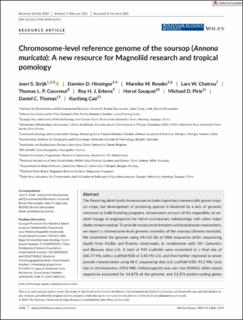| dc.description.abstract | The flowering plant family Annonaceae includes important commercially grown tropical crops, but development of promising species is hindered by a lack of genomic resources to build breeding programs. Annonaceae are part of the magnoliids, an ancient lineage of angiosperms for which evolutionary relationships with other major clades remain unclear. To provide resources to breeders and evolutionary researchers, we report a chromosome-level genome assembly of the soursop (Annona muricata). We assembled the genome using 444.32 Gb of DNA sequences (676× sequencing depth) from PacBio and Illumina short-reads, in combination with 10× Genomics and Bionano data (v1). A total of 949 scaffolds were assembled to a final size of 656.77 Mb, with a scaffold N50 of 3.43 Mb (v1), and then further improved to seven pseudo-chromosomes using Hi-C sequencing data (v2; scaffold N50: 93.2 Mb, total size in chromosomes: 639.6 Mb). Heterozygosity was very low (0.06%), while repeat sequences accounted for 54.87% of the genome, and 23,375 protein-coding genes with an average of 4.79 exons per gene were annotated using de novo, RNA-seq and homology-based approaches. Reconstruction of the historical population size showed a slow continuous contraction, probably related to Cenozoic climate changes. The soursop is the first genome assembled in Annonaceae, supporting further studies of floral evolution in magnoliids, providing an essential resource for delineating relationships of ancient angiosperm lineages. Both genome-assisted improvement and conservation efforts will be strengthened by the availability of the soursop genome. As a community resource, this assembly will further strengthen the role of Annonaceae as model species for research on the ecology, evolution and domestication potential of tropical species in pomology and agroforestry. | en_US |

